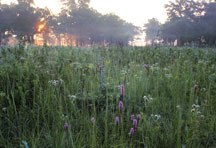Main Content
Article
Indiana Prairie
Prairies have always been a symbol of the Midwest, a part of our natural heritage, and a part of Indiana's natural history.
In presettlement times, tall-grass prairies occurred in a vast area which extended from Iowa and Missouri to central Ohio. In Indiana, prairies made up about 15 percent of the area, primarily in northwest and west-central portions of the state. Most of the original prairie in the state has been lost to drainage, urbanization and agriculture. A few high-quality remnant areas such as Hoosier Prairie in Lake County have been preserved.
Prairie
A complex natural community covered with a dense mixture of tall grasses and other herbaceous plants. Although woody plants are not a major component of prairie, trees such as black oak and bur oak and shrubs such as prairie willow and New Jersey tea are found there.
Types of Prairies
There are several different types of prairie due primarily to differences in soil moisture and soil type. These range across a spectrum from dry to wet, and include many in-between types such as mesic and dry-mesic. Indiana's prairies originally included rich black-soil (silt loam) prairies and sand prairies.
The soils of black-soil prairies were extremely rich, and as a result, nearly all of these were plowed for agriculture. High-quality remnants of black-soil prairies are rare in Indiana. Many of the small remnant prairie tracts that remain in Indiana are pioneer cemeteries and old railroad right-of-ways that were never plowed.
Prescribed Fire
Fire was an important factor to maintaining natural prairies by helping keep trees out. The fires were started by lightning and Native Americans. Fires killed tree seedlings but not the prairie plants with their extensive underground roots.
Plants that occur in prairies have special adaptations such as extensive and deep root systems and hairy leaves and stems that help them survive dry periods. Fire, in fact, tended to stimulate the growth of prairie plants, which were quick to resprout following fire.
Today, in the absence of natural fires, prairies are managed by human-initiated fires. Controlled fires are set by trained professionals in the DNR so that prairies may continue to occur in their natural condition.
Visit our list of Nature Preserves page to discover Indiana's dedicated Nature Preserves protecting prairie communities.
Prairie-Preserved Nature Preserves
- Gibson Woods Nature Preserve - Lake County
- Hoosier Prairie Nature Preserve - Lake County
- Post Oak-Cedar Nature Preserve - Harrison County
- Sandhill Nature Preserve - Pulaski County
- Spinn Prairie Nature Preserve - White County

